
Atlas F1 Senior Writer
Alongside on-track racing, Formula One is as much about the off-track politicking and regulation challenges. Seeing the competition decided in court has become very much a fixture of this sport as pit stops or on-track passing. But how do the wheels of justice really turn in Formula One? How did it work in the case of Jordan and Jarno Trulli at the 2001 US Grand Prix? Or in the case of Michael Schumacher and the Benetton team in 1994?
Atlas F1's Thomas O'Keefe brings an unprecedented study on the FIA's justice system and its very own Court of Appeal. In a four part feature, he reveals never-before-published evidence on how this unique system works
Who would envy those in the FIA rule-making apparatus that are trying to keep in check 22 of the world's fastest cars and drivers? Who would envy them, when they face the task with just a small band of scrutineers, wielding little more than moral suasion, a sporting sense of fair play, and the indispensable thick Rule Book that covers everything from passing under the yellow flag to the analysis of fuel samples?
And who is charged with making the key judgment calls as to enforcing this plethora of rules? According to Chapter X, Article 141, of the FIA's International Sporting Code (April 4th 2001 edition), "the stewards of the meeting shall have supreme authority" for the enforcement of the FIA's rules. As in any sport, umpires like these three Stewards have to project professionalism and intelligence in the way they go about their work.
Above all, with the hundreds of millions of dollars at stake for the manufacturers in Formula One, the Stewards have to be perceived as unimpeachably fair and impartial in their decisions, affecting as they do not only the careers of drivers but also the economic and sporting prospects of the eleven Formula One teams that collectively spend a staggering $1.7-2.0 billion dollars per year to put their cars on the grid.
When it comes to fairness in the administration of Racing Justice, a quasi-judicial body called the FIA's International Court of Appeal can be found on the top of the heap. If a competitor disagrees with a punishment meted out by the Stewards of the Meeting, the Court of Appeal is the court of last resort. The Mission of the International Court of Appeal is set forth in Chapter XIII, Article 184, of the International Sporting Code:
The Court of Appeal has plenary power and "may decide that the penalty or other decision appealed against should be waived, and, if necessary the penalty mitigated or increased." It lacks only one power: the Court of Appeal "shall not be empowered to order any competition to be re-run" (this from article 189). Furthermore, in article 185, competitors are discouraged from using the Court of Appeal willy nilly: "if the International Court of Appeal considers the appeal to be frivolous, the appellant may be sentenced to a fine of a maximum of 1 million francs in addition to any other fee."
Article 188 of the Code contains other significant provisions. The Court of Appeal is to be composed of 15 Titular Members of different nationalities (and 15 Deputy Members of the same nationalities) and they "must constitute a body of international competence, both sporting and legal." According to the FIA, this means that the judges have a motorsport background but are no longer involved in any way in Formula One. Members belonging to the countries concerned by the appeals will not sit in judgment.
In order to assure a speedy trial, the intention of a competitor to appeal must be announced within one hour after the Stewards' decision is published. Within 48 hours of such notice the National Sporting Authority of the appealing competitor files the appeal on behalf of the competitor, i.e. the Royal Irish Automobile Club for B&H Jordan Honda, the Automobil Club d'Italia - Commissione Sportiva Automobilistica Italiana - for Ferrari, the Royal Automobile Club for McLaren, and so forth. The time limit for perfecting an appeal to the Court of Appeal is seven days.
On the day of the appeal, the Court of Appeal hears all parties and examines all the documents and other evidence submitted to it. Any competing team which may be directly and significantly affected by the decision of the Court of Appeal may also request a hearing. Traditionally, the Court of Appeal acts within days of the hearing. Most importantly, the FIA has let it be known that as of 2001, journalists will be permitted to attend the hearings before the Court of Appeal.
How important to the teams are the rulings of the Court of Appeal? In the course of the deliberations leading to the settlement of the antitrust case brought against Formula One by the European Commission earlier this year, the Commission added a term to the settlement that was intended to give teams the assurance that the FIA Court of Appeal could not be arbitrary.
The Commission required that Article 189 be modified to insert "a positive declaration that judgments of the FIA's Court of Appeal shall be reasoned" and also proposed a new subarticle provision (Article 191(b)) making it clear that "nothing in the code shall prevent any party from pursuing any right of action which it may have before any Court or Tribunal." Indeed, in the current version of the International Sporting Code, Article 189 entitled "Judgment" now states: "Judgments of the Court of Appeal shall be reasoned."
One decision by the Court of Appeal must have particularly rankled Dennis: Mika Hakkinen's disqualification from the 1997 Belgian Grand Prix for non-conformity of a fuel sample taken from Mika's car during a practice session (he qualified 5th) with the fuel "fingerprint" McLaren had on file with the FIA. McLaren resisted the punishment meted out by the Stewards - exclusion of Hakkinen from the results of the race - and appealed. Hakkinen had finished second to Michael Schumacher in the race.
The Court of Appeal ended up throwing the book at the team. McLaren argued that the variance in the fuel sample was not deliberate but due to evaporation and the variation did not confer a performance advantage. The Court was left unmoved. Although stopping short of charging McLaren with acting in bad faith ("Whereas, in this case the bad faith of McLaren concerning a possible deliberate infringement cannot be established..."), the Court of Appeal affirmed Hakkinen's exclusion from the event and increased the fine for the infringement from $25,000 to $50,000.
The FIA wanted more and recommended as a "sentence" not only exclusion from the race but a $200,000 fine as well as a further fine of 1 million French Francs for filing a frivolous appeal. To its credit, the Court of Appeal resisted the FIA's recommended financial sanctions. Nonetheless, it is no wonder that dealing with the FIA and the Court of Appeal has left Ron Dennis with a bad taste in his mouth.
Dennis felt so strongly about this issue of fairness in the administration of Racing Justice that he, perhaps joined by Frank Williams, reportedly wrote to the European Commission to make his case for requiring an external route to appeal and for reasoned FIA Court of Appeal decisions. Atlas F1 asked for copies of these communications, but neither the teams nor the European Commission will release the letters or confirm their content; incredibly, even the FIA does not have copies of these letters.
Nevertheless, in a recent interview with F1 Racing, Dennis laid bare his suspicions about the Court of Appeal: "I would go further than Max seems to be prepared to go to demonstrate total impartiality - and, in respect of the Court of Appeal, complete independence. I still have a deep-rooted mistrust of the Court of Appeal, as does every other team ... perhaps with the exception of one." Take a guess which team he's talking about!
But whatever was said in the Dennis/Williams letters seems to have taken root amongst the Commission's staff since the final version of the European Commission settlement does provide that the FIA shall insert a new clause in its Sporting Regulations "clarifying that anyone who is subject to FIA decisions can challenge them before the national courts." Furthermore, the European Commission's announcement of the settlement noted that the "FIA submissions [in the antitrust case] have confirmed the availability of legal challenge against FIA decisions both within the FIA structure and before national courts."
According to Max Mosley, as a practical matter and "as a matter of law, it has always been possible to challenge our Court [of Appeal] in the ordinary courts. This has indeed been done on several occasions in France, but never successfully." And as for the "reasoned decisions" requirement, to Mosley this was surplusage: "Our Court of Appeal's decisions have in fact always been reasoned, but we don't mind the European Commission taking the credit for this."
Although the Court of Appeal is one of Formula One's less well known institutions, the importance of its role when it acts was demonstrated when the Court of Appeal threw out Jarno Trulli's disqualification by the Stewards from a hard-fought fourth place at the 2001 US Grand Prix at Indianapolis for a "skid block" infraction under Article 3.13.1.d of the Formula One Technical Regulations ("non-conformity of skid block dimensions" in the FIA's argot) and reinstated his and Jordan's points. The hearing took place in Paris on October 26th 2001.
Result? Trulli got back his fourth place, Eddie Irvine's Jaguar was demoted to fifth place in the Grand Prix, Eddie Jordan's Honda-backed team moved up a notch to fifth place in the Constructors' Championship and Jordan's arch-rival BAR-Honda descended further down in the order to sixth place in the Constructors Championship. There were also financial consequences to the decision when it comes to sharing TV revenues and "travel-money", with the Jordan team coming out ahead of BAR-Honda in the budget sweepstakes for 2002.
Strangely, none of these outcomes of the Trulli decision was driven by the merits, although Trulli and Jordan came prepared to make their case to the Court of Appeal, arguing that the skid block had gotten damaged and dislodged in the course of an accident at Turn 1 on Lap 2 of the Indianapolis race with the two Saubers which was a serious enough jolt to lead to Kimi Raikkonen's departure from the race.
Here is the legalese version of the defense put on by Trulli and Jordan, as recited in the full text of the Court of Appeal's decision, provided to Atlas F1 upon written request from the Secretariat of the FIA International Court of Appeal in Paris:
WHEREAS with this loss of pressure, which reduced the capacity of the car to maintain a certain height, there was damage and loss of the two fasteners which led the skid-block to slide down and undergo extreme damage as a result of its contact with the track, and there was therefore under these circumstances no intention to stretch the regulations or to cheat."
But who needs the merits when you have something even better available: a procedural technicality. As the Court of Appeal prepared for the hearing, among the witnesses Jordan listed for its side was a Dr. Michael Ansell, a "handwriting expert" who, you could assume, knew little about the engineering properties of skid blocks. Instead, Dr. Ansell had the Smoking Gun: he was prepared to testify that one of the signatures of the Stewards on the Trulli disqualification document was not authentic.
What Dr. Ansell had to say swept away all of the rest of the technical evidence on the dangling skid block. So, instead of a full-fledged hearing on the merits, the Court of Appeal in the Trulli case overturned the Stewards decision because it turned out that in calling Trulli on the carpet the Stewards themselves were not following their own rules.
Article 134 of the International Sporting Code is entitled "Necessary Officials" and states as follows: "At a meeting there shall be at least three stewards of the meeting and a clerk of the course ... The stewards officiate as a body under the authority of the chairman expressly designated in the Supplementary Regulations. The chairman of the panel of the Stewards of the Meeting is, in particular, responsible for establishing agendas and drawing up the minutes of the meeting."
In other words, the three Stewards are to act as a body together in real time, and in this case one Steward was absent during the hearing of the Jordan team, which occurred about 5pm on Race Day, and that single mistake by the officialdom was enough to win the case for Trulli and Jordan.
There is one further key provision that seems to have been overlooked in the Trulli case and that could have saved the day. One of the last clauses of Article 141 as to "Authority of the stewards of the meeting" states: "in the event of the absence of one or several of the stewards of the meeting, they may appoint one, or, if necessary, several substitutes, especially when the presence of three stewards is indispensable." Had the remaining Stewards that day at Indy appointed a substitute, the BAR-Honda team might have more travel money for next year.
Who put Dr. Ansell on to the inauthentic signature? Easy: alert witnesses from the Jordan team who knew the International Sporting Code were their own best lawyers. Although there were three signatures on Trulli's Notice of Penalty, Trevor Foster of Jordan Grand Prix, who accepted receipt of the penalty, knew only two Stewards were present for the meeting and presumably the team was prepared to raise that somewhat embarrassing point had the Court of Appeal hearing gone forward.
But exactly who were the "stewards of the meeting" at Indy? Based upon other documents issued by the Stewards that weekend, the three stewards were Paul Gutjahr, a Swiss; Steve Earle, an American; and Roger Peart, a Canadian. Although it is not clear how much testimony was taken on this missing steward, here is the extraordinary conclusion reached by the Court of Appeal in its decision, reported here for the first time, in the Court of Appeal's own words:
WHEREAS at the hearing Mr. Pierre de CONINCK, in his capacity as Secretary-General of the FIA Sport Department, asked to take the floor to announce that there had been in effect irregularities in the procedure and requested, under such circumstances, that the International Court of Appeal note the nullity of the decision of the Stewards of the Meeting taken at the United States Grand Prix where Car. No. 11 belonging to the competitor Jordan Honda, driven by Jarno TRULLI, was excluded;
WHEREAS Mr. Timothy KING, on behalf of Jordan Honda, also asked that the nullity of the decision in question be noted;
WHEREAS the International Court of Appeal must therefore rule on the grounds of nullity of the decision, nullity which was referred to by both the FIA and the competitor Jordan Honda;
WHEREAS Mr. Roger PEART, Chairman of the Panel of the Stewards of the Meeting informed the FIA that in effect he had not been able to be present when the representatives of the Jordan Honda team were heard, but that he had been fully informed of the case and the he had agreed with the other Stewards of the Meeting to exclude Car No. 11;
WHEREAS in this case, the International Court of Appeal must recall Article 134 of the International Sporting Code the terms of which provide that the Stewards of the Meeting must be three in number and they shall officiate as a body under the authority of a Chairman;
WHEREAS this Panel's [i.e., the Stewards] mission, notably, is to hear the competitor who must be summoned;
WHEREAS in this case, the fact that the competitor was heard by only two Stewards of the Meeting - in the acknowledged absence of the Chairman of the Panel, the latter who as a result was unable to form a personal opinion as to the explanations provided by the competitor - violates the rights of the defense and results in the absolute nullity of the decision;
WHEREAS under these conditions, the International Court of Appeal, noting the nullity of the decision taken, must quash it."
In effect, this was a case where the accused was set free "because the constable has blundered" - as future United States Supreme Court Justice Benjamin N. Cardozo famously characterized a case in New York where a criminal was released because the police did not follow their own due process procedures. Although in Trulli's case the FIA's Court of Appeal did not go further and call for punitive action against the Chairman of the Panel of Stewards such as requiring him to turn in the Superlicense that qualifies him as a Steward, the Court of Appeal clearly went out of its way in this, the first substantive matter since the European Commission Settlement, to establish that as an institution it is above the fray and independent of the race official bureaucracy.
Interestingly, it will be recalled that the Stewards had a busy time that weekend at Indy. I remember the shock in the Media Center when the FIA notice was posted on the bulletin board advising us that Mika Hakkinen was being punished for running a red light when the pitlane got congested due to an incident on the track. Three signatures of the Stewards there, too. This was the full text of the Steward's report on the Hakkinen incident:
If the grizzled veterans of the jaded press corps were shocked, you can imagine what Ron Dennis and Mika Hakkinen felt when the news was delivered. It must have been a particularly bitter pill for all concerned as Mika, who had celebrated his 33rd birthday on race weekend, turned in a fabulous qualifying time of 1:11.945 that originally put him on the front row next to Michael Schumacher, who was on pole at 1:11.708, before the penalty demoted Mika to fourth on the grid. Taken together with Mika's exit in flames from Indy in the USGP 2000, it was beginning to look like Mika had inherited the Indianapolis Bad Luck of his former teammate at McLaren in 1993, Michael Andretti.
Which is why Michael Schumacher was so correct to point out generously in the post-race press conference that there was "Justice" in Mika winning the 2001 US Grand Prix on such an ill-starred weekend ("I am happy for Mika because he won it fair and square"), Mika's last victory as it may turn out.
"The International Court of Appeal shall be entrusted with judging definitively any dispute or conflict resulting from the application of the Statutes or of the rules decreed by the FIA, with settling any dispute of a sporting nature arising between Members of the FIA, and with hearing any litigation of a sporting nature which may be submitted to it by the President of the FIA."
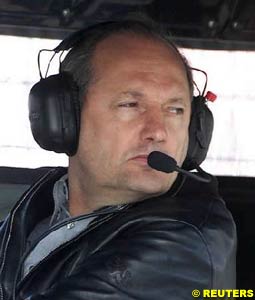 It is thought that these provisions of the settlement were incorporated by the European Commission in response to the request of certain team principals, notably Ron Dennis of McLaren, which has been on the receiving end of the FIA's rulings over the years and apparently wanted to have the comfort of knowing that if the FIA was to rule against a team, the Court of Appeal would at least have to articulate the reason for its decision and to have an external litigation option available for those situations where the due process being meted out by the FIA's International Court of Appeal was, in his view, actually or potentially compromised.
It is thought that these provisions of the settlement were incorporated by the European Commission in response to the request of certain team principals, notably Ron Dennis of McLaren, which has been on the receiving end of the FIA's rulings over the years and apparently wanted to have the comfort of knowing that if the FIA was to rule against a team, the Court of Appeal would at least have to articulate the reason for its decision and to have an external litigation option available for those situations where the due process being meted out by the FIA's International Court of Appeal was, in his view, actually or potentially compromised.
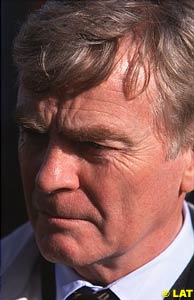 The innocent looking provision Ron Dennis sought would presumably only be used in extraordinary situations but seems to be important to certain of the teams as a backstop to ensure that the FIA understands that its actions are subject to external oversight. As the European Commission stated in announcing its recommendations, the modifications to the Sporting Regulations include the following objective: "to improve transparency of decision-making and appeals procedures and to create greater accountability." As of the April 2001 edition of the International Sporting Code, however, the external appeal option to be designated subarticle Article 191(b) had not yet been incorporated into the Code.
The innocent looking provision Ron Dennis sought would presumably only be used in extraordinary situations but seems to be important to certain of the teams as a backstop to ensure that the FIA understands that its actions are subject to external oversight. As the European Commission stated in announcing its recommendations, the modifications to the Sporting Regulations include the following objective: "to improve transparency of decision-making and appeals procedures and to create greater accountability." As of the April 2001 edition of the International Sporting Code, however, the external appeal option to be designated subarticle Article 191(b) had not yet been incorporated into the Code.
"WHEREAS the appellant [Jordan] maintains that if the thickness of the skid-block of Car No. 11 [Trulli's Jordan] did not respect the prescriptions of Article 3.13.1.d of the Technical Regulations (less than 10 mm with a tolerance of more or less 1 mm), it was due to the damage of the two fasteners of this skid-block following the collision between Car No. 11, driven by Jarno Trulli, and Car No. 17 [Raikkonen's Sauber] at the first curve during the second lap of the race, and the ensuing shock which caused a loss of pressure in the back right wheel (33%), according to the indications given by the manufacturer, Bridgestone;
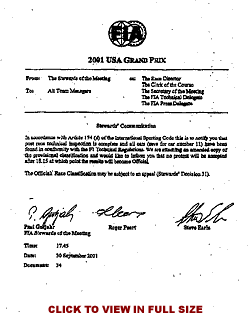 Sounds reasonable and plausible, doesn't it? But because the Court of Appeal tends not to take kindly to defenses of competitors that sound like "we had no performance advantage" or there were "exceptional circumstances" or "it was unintentional," which the FIA seems to regard as equivalent to The-Dog-Ate-My-Homework, Trulli and Jordan would have in all likelihood lost the case if it had gone to a full submission of the proof and a decision on the merits. It should be remembered that even the formidable combination of Flavio Briatore and Michael Schumacher could not beat the skid block rap back at Spa in 1994 when the skid block under Schumacher's Benetton-Ford was deemed to have been worn down beyond the permitted tolerances.
Sounds reasonable and plausible, doesn't it? But because the Court of Appeal tends not to take kindly to defenses of competitors that sound like "we had no performance advantage" or there were "exceptional circumstances" or "it was unintentional," which the FIA seems to regard as equivalent to The-Dog-Ate-My-Homework, Trulli and Jordan would have in all likelihood lost the case if it had gone to a full submission of the proof and a decision on the merits. It should be remembered that even the formidable combination of Flavio Briatore and Michael Schumacher could not beat the skid block rap back at Spa in 1994 when the skid block under Schumacher's Benetton-Ford was deemed to have been worn down beyond the permitted tolerances.
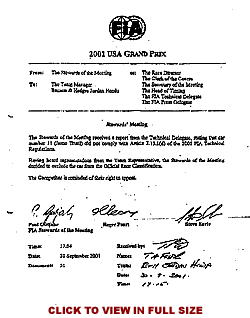 In response to this article, Max Mosley dismissed charges that one of the Stewards' signature was forged but did concede that another official had to sign on behalf of one of the Stewards, after the missing Steward had left the track before the technical checks that led to Trulli's disqualification. In effect, the Missing Steward claimed that he gave his Power of Attorney to his other two colleagues but that was not permitted under the "we act as a body" culture of the Stewards. Under the circumstances, the International Court of Appeal had little choice and pronounced the Stewards' decision null and void.
In response to this article, Max Mosley dismissed charges that one of the Stewards' signature was forged but did concede that another official had to sign on behalf of one of the Stewards, after the missing Steward had left the track before the technical checks that led to Trulli's disqualification. In effect, the Missing Steward claimed that he gave his Power of Attorney to his other two colleagues but that was not permitted under the "we act as a body" culture of the Stewards. Under the circumstances, the International Court of Appeal had little choice and pronounced the Stewards' decision null and void.
"WHEREAS concerning the decision of exclusion itself, the appellant [Jordan] claims that only two Stewards of the Meeting, and not three, were present at the meeting when the representatives of the Jordan Honda Team were heard, even though the decision is signed by three Stewards of the Meeting including the Chairman of the Panel, Mr. Roger PEART, who was not present during the discussion;
"The Stewards of the Meeting received a report from the Race Director [Charlie Whiting], stating that the Driver of car number three (Mika Hakkinen) exited the pit lane [during Sunday Warm-Up] when the exit lights were red. Having heard from both the driver and team representative and viewed video evidence, the Stewards of the Meeting decided to delete the fastest qualifying time of the driver of car number three (Mika Hakkinen). The Competitor is reminded of their right to appeal."
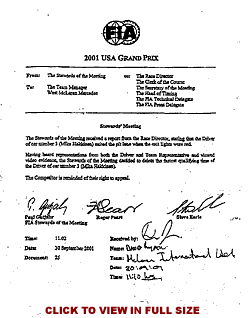 In light of what happened in the Trulli case, which happened six hours later on the same day, the formalities of the Hakkinen/McLaren penalty document are interesting. Signatures of the above-mentioned three Stewards - Gutjahr, Peart and Earle - are evident as is the time of issuance, 11:02am on September 30th 2001, Race Day morning. McLaren International acknowledged receipt of the Notice of Penalty at 11:10am, less than an hour from the Formula One Grid Presentation at 11:45am.
In light of what happened in the Trulli case, which happened six hours later on the same day, the formalities of the Hakkinen/McLaren penalty document are interesting. Signatures of the above-mentioned three Stewards - Gutjahr, Peart and Earle - are evident as is the time of issuance, 11:02am on September 30th 2001, Race Day morning. McLaren International acknowledged receipt of the Notice of Penalty at 11:10am, less than an hour from the Formula One Grid Presentation at 11:45am.
Next week: a look at how Michael Schumacher and others have fared in the Halls of Racing Justice.
Please Contact Us for permission to republish this or any other material from Atlas F1.
|
Volume 8, Issue 5
Atlas F1 Exclusive
The FIA's Court of Appeal: Final Answer?
Williams 2002: Improving the Average
Articles
Miracle at Imola
Columns
Rear View Mirror
Bookworm Critique
The Weekly Grapevine
> Homepage |